A Mid-priced Value vs Performance Contender
Vortex makes a wide array of optics for shooting enthusiasts. They also offer apparel and training. This article covers one product in particular – the Vortex Venom red dot.
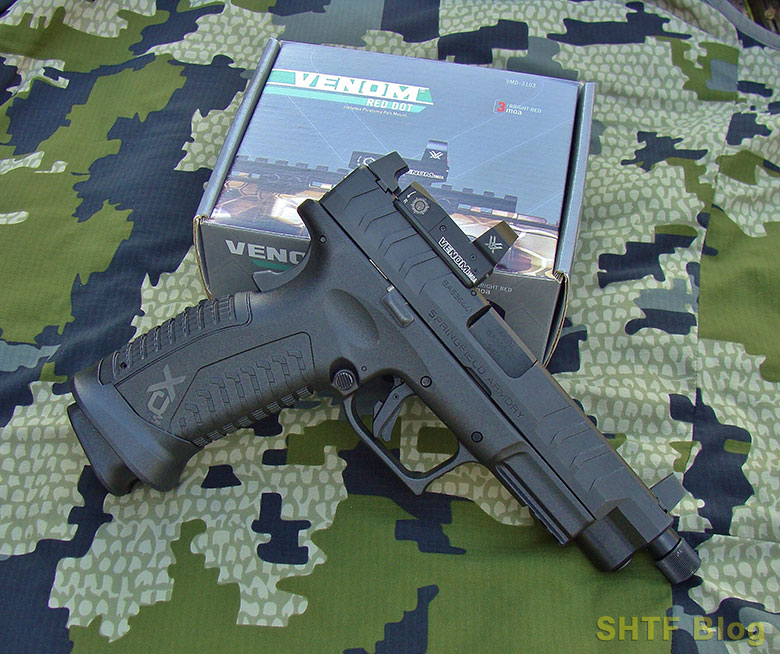
A related but separate future post will cover the mounting and zeroing of a miniaturized red dot sight and the MRDS that served to illustrate the process is just one of many similar examples. Specifically, it was one of three small versions sold by Vortex, cataloged as Razors, Vipers, and Venoms.
- The Venom Red Dot Sight-3 MOA promotes rapid target acquisition while providing a precise point of aim; getting shots down range and on target fast. The Venom's aluminum housing ensures this unit will...
- High quality, fully multi-coated lenses offer a clean, wide field of view. Power and dot intensity controls are conveniently located on the left side of the sight to choose between 10 brightness...
- The Venom also has an auto-brightness mode that uses an ambient light sensor to control dot intensity if the shooter prefers. Parallax Free
- 1 MOA wind age and elevation adjustments are super sleek and make sighting in a breeze. The top load system makes changing the CR1632 battery a breeze, as you will not have to remove your sight to...
The Venom can also be found at Cabela’s and at Optics Planet. Compare prices before buying.
The project involved the latter and the job was pretty much hassle free, but the sight itself took second billing to its installation. Given the satisfactory outcome, the Venom seemed deserving of a closer look.
Vortex Optics
As I’ve noted during previous posts, Vortex has become a major optics player. They market an extensive line of optics to include binoculars, scopes, and dot-sights, etc. Nowadays, a plethora of so-called “red dot sights” are commonly mounted to AR-type carbines and even small pistols.
I’ve reviewed some of their other products as well. See my reviews of the Vortex Diamondback Tactical and the Vortex Strike Eagle scopes.
Vortex was on this early and their ever-evolving line of dot-sights is now comprised of both closed and open-emitter designs. The former, featuring front and rear lenses, are good matches for carbines, whereas the comparatively tiny open emitters are more suitable for handguns. Of note, Vortex’s miniaturized offerings have persevered despite an increasingly crowded market.
Vortex Venom Overview
One feature I continue to appreciate is Vortex’s packaging. The pertinent specs are listed on the box for easy reference (illustrated here via the photos). The foam-lined box includes the sight, a separate QD Picatinny base, three mounting screws, a torx-tipped Allen wrench, a dual-ended screwdriver (for sight adjustments and the battery cap), a CR 1632 battery, and a rubber protective cap – everything needed for a kitchen table installation except a tube of thread-sealant. A clear set of directions and lens cloth are also included.
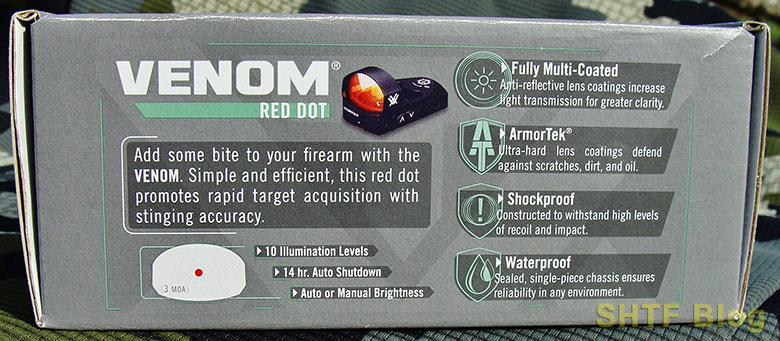
The Venom’s housing is machined from aluminum, and its glass lens surfaces are multi-coated. This treatment helps prevent scratching and also improves light transmission. Field of view is generous given the sight’s small size, but it’s large enough to permit a top-loading battery – a feature that avoids the hassle of sight removal and re-zeroing endemic to ultra-low underside battery designs.
The lid is slotted to match the Vortex tool or any similar item. The battery is rated to last 150 hours on the dot’s brightest setting, but it’s supposedly good for 3000 hours on still useful lower settings. Battery life is further extended by the sight’s auto-shutoff feature.
The Venom’s is sold in two reticle sizes: a relatively fine 3-moa red dot, and 6-moa version more suitable for fast handgun work. Two arrowed rubber push-pads on the sight’s left side regulate the dot’s intensity, along with a few additional settings options.
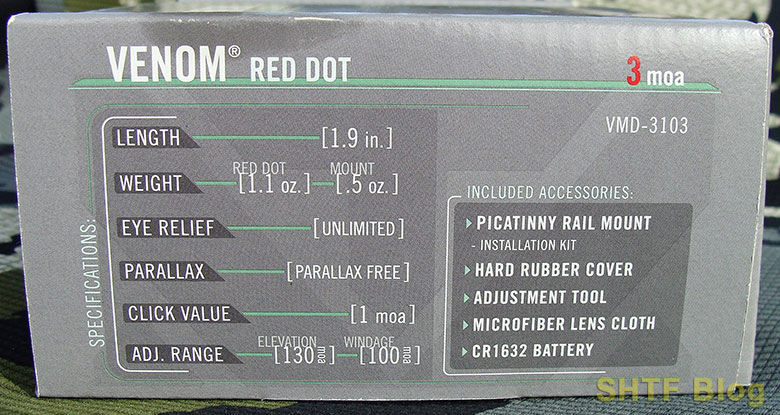
The sight is zeroed via a pair of small elevation and windage dials, recessed and slotted for a small flat-tipped screwdriver or the Vortex tool. The adjustment screws are surrounded by unnumbered reference scales however, the graduations correspond with distinct 1-moa clicks. To avoid confusion, the radial scales are accompanied by directional arrows with “UP” and “R” cues.
Total range of adjustment is 130-moa for elevation and 100-moa for windage, enough to accommodate most mounting systems. FYI, one “minute-of-angle” is 1/60th of a degree, which works out to roughly one inch at 100 yards (actually, 1.047”).
Speaking of mounts, some of the smallest MRDS units can create sighting-in headaches due to their locking screws. The Viper is such an example. It sits lower than the Venom and could be a better match for some pistol sights if co-witnessing is a priority. However, like some other completive offerings, the Viper’s dials are locked via two small setscrews on the rear of its housing.
With optics-ready slides now the rage, it’s possible they may be inaccessible if the MRDS is in close proximity to a rear sight. The Venom’s deck is .080” taller but the adjustments are accessible – and its housing is thick enough for a top-loading battery. It’s rear surface also displays two vertical white stripes that could serve as a makeshift rear sight if complete co-witnessing isn’t possible.
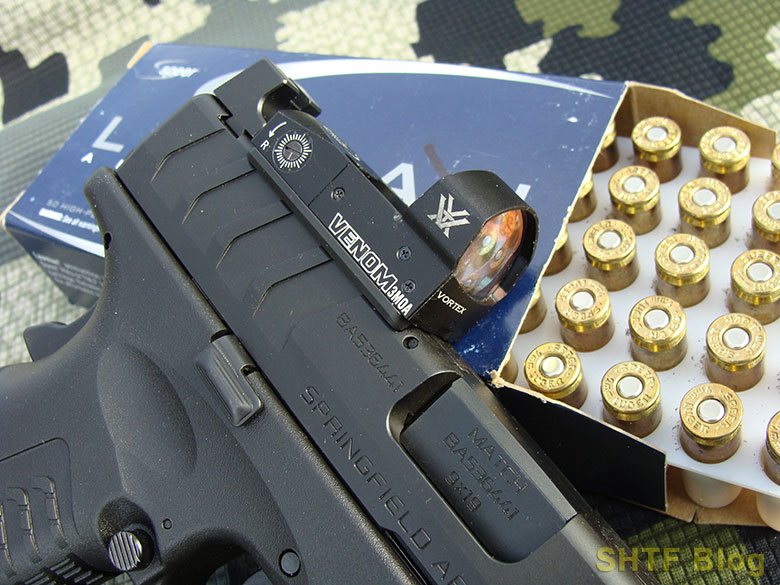
The Venoms ship with a protective rubber cover and are advertised as waterproof. For further reassurance, they’re covered by Vortex’s lifetime warranty.
Powering It Up
After unscrewing the battery cap with the Vortex tool, I carefully installed its included battery (numbers up). Replacing the cap seemed simple enough, but that step turned out to be rather fiddly. With the cap finally secured, according to the instructions, a press of either rubber button should activate the dot. Sure enough, the reticle came to life. So far, so good…
Reticle
The Venom reviewed here is their 3-moa version. A positive first take, I found the dot was bright enough at the highest setting to be useful in bright midday sunlight, even against white targets. If mounted on a rifle I’d personally prefer a finer 2-moa dot, but this one seemed “right” atop its host; a Springfield Armory XD-M Elite 9mm pistol.
Settings
In all, there are ten brightness settings (non-night vision). Two modes are also available: “auto” and “manual.”
The Venom can be turned off by pressing and holding the “down” pad for 5 seconds.
If set to “auto” the reticle will automatically adjust to ambient light conditions. To gain this feature, press and hold the “up” arrow until the dot flashes three times. In “auto,” the sight will also shut off at 14 hours if undisturbed.
To engage the “manual” setting, press and hold the same “up” pad until the dot blinks twice. There’s no auto-shutoff feature in this mode but, as I discovered, it’s worth understanding for optimum results in dim light.
Motion Features
No instant-on for the Venoms: Instead, per above, it’s designed to switch off, if in “auto”, after sitting idle for 14 hours. A simple press of either pad will reenergize the dot to an intensity governed by an auto sensor located at the housing’s rear. In “manual,” the sight will stay on unless shut off via the “down” pad.
Mounting
There is no one-size-fits-all MRDS “footprint”, but some brands do share the same patterns. The Venom uses the popular Doctor Optic and Burris Fast-fire layout. The included Picatinny rail mounting plate is machined accordingly – if it’s needed.
Since this unit was destined for an “optics ready” pistol slide, the solution was a proprietary Springfield Armory adapter plate (some other systems direct mount to slides). As noted above, the specific installation and zeroing process will be covered through a separate post. For now, the short story is, it was hassle free.
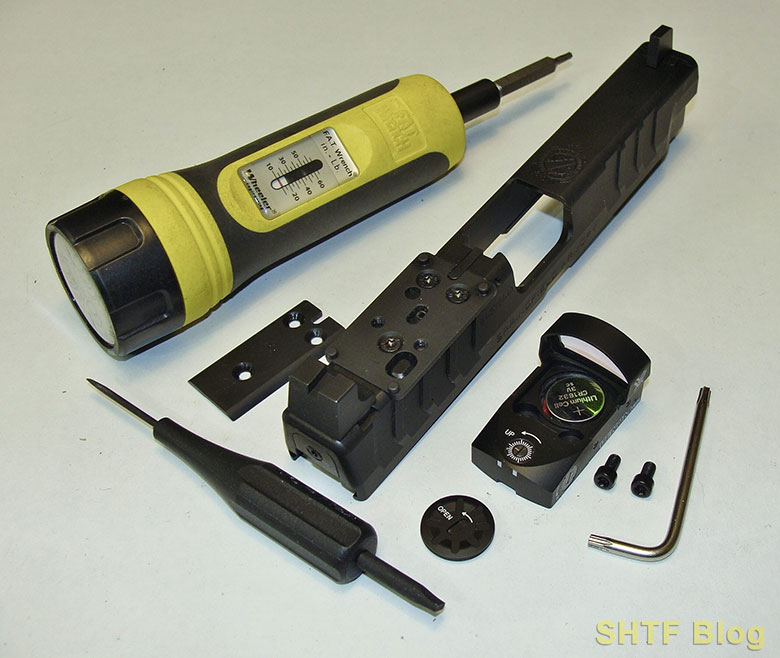
As for the pistol, it’s fair to rate SA’s polymer-framed XDs as among the top-selling hi-cap striker-fired firearms. The Venom neatly occupied the relieved slide of the XD-M and, as a bonus, it sat low enough to co-witness with its iron sights.
The solution for conventionally stocked firearms equipped with Picatinny-type bases is the included Vortex mount. It’s sits low enough to provide a cheek-weld for 3-gun shotguns, a number of conventional rifles, some pistol-caliber carbines, and properly equipped revolvers. But it’s too low for AR-15s.
The fix for flat-top ARs is a high mount. The Vortex QD version elevates the reticle to provide a BUIS co-witness in the lower 1/3 of the Venom’s field of view. Other options include a solid riser and 45-degree offset mount.
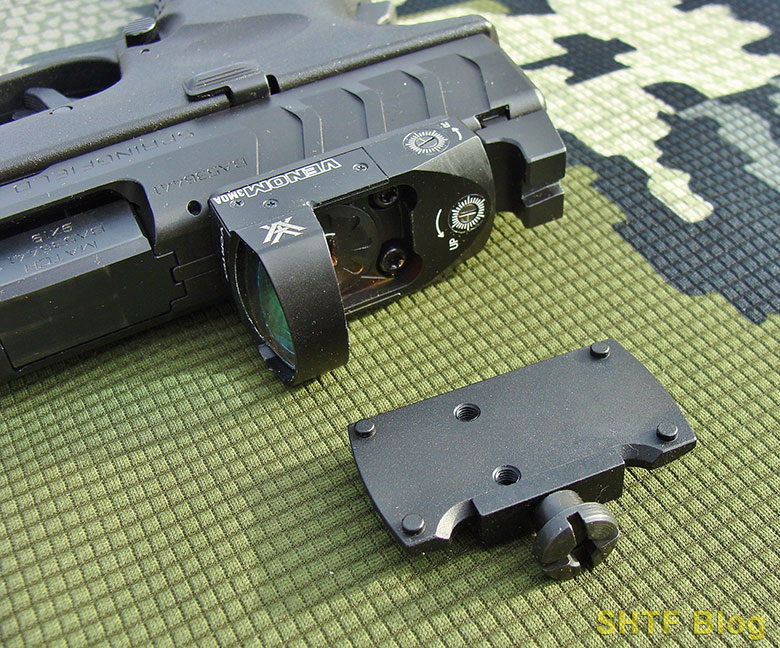
Sighting-in
Zero was accomplished by keying the sight to “manual” and dimming it to gain fine dot. Thanks to a few ammo-saving pre-fire mounting tricks (covered separately) sighting-in was a cinch at 25 yards. The adjustments tracked as advertised and, because MOA is an angular measurement, at this common handgun distance, each click translated to only a quarter inch. But there was a bumpy start.
Upon the first shot the reticle disappeared. Turned out the battery cover was no longer present! Good thing I was standing on a bare surface. Miraculously, the cap didn’t fly to places unknown during the energetic cycling of the XD’s slide. Expecting the worse, I quickly found it near my feet and declared a time-out for a post-mortem exam.
So much for “securing” the cap. It took a few attempts but, after holding my mouth just right, the cover finally threaded on properly. A few more practice installations nailed the technique. No further issues after that, but it’s certainly something worth noting.
As mentioned in previous posts, I normally include tracking checks with rifle scope reviews, but dot sights are different breeds. Like most other shooters, once I’ve established zero, the turrets typically remain undisturbed. In this case the adjustments seemed positive, and no zero shifts were encountered. Switching to auto-mode, the dot also coped well with the outdoor range’s lighting conditions.
Last Comments
A few on-line dings pertained to the excessive brightness of the Venom’s reticle during low-light hunting conditions. Since it was deer season, I stepped into the woods on my property at sunset to see what would transpire. And, yes, in the waning minutes of legal time, 20 minutes after sundown, it was too bright – in “auto” mode.
But a simple switch to “manual” permitted dimming of the dot to a useful intensity in thick cover, throughout the duration of the legal 30-minute post-sundown period. The flaring associated with “auto” also disappeared to provide an intuitive aiming system.
- The Venom Red Dot Sight-3 MOA promotes rapid target acquisition while providing a precise point of aim; getting shots down range and on target fast. The Venom's aluminum housing ensures this unit will...
- High quality, fully multi-coated lenses offer a clean, wide field of view. Power and dot intensity controls are conveniently located on the left side of the sight to choose between 10 brightness...
- The Venom also has an auto-brightness mode that uses an ambient light sensor to control dot intensity if the shooter prefers. Parallax Free
- 1 MOA wind age and elevation adjustments are super sleek and make sighting in a breeze. The top load system makes changing the CR1632 battery a breeze, as you will not have to remove your sight to...
The Venom can also be found at Cabela’s and at Optics Planet. Compare prices before buying.
This particular Venom and XD-M pistol belong to my son. He purchased it based on good results with two other Venoms mounted to an AR-15 (with a QD riser), and an S&W Performance Center Model 686 .357 revolver (using the standard Vortex base).
Last year, on the last day of our deer season, he took a bonus doe with the revolver in the few remaining minutes of evening light. He reported no issues and said the key to such use is the lowest “manual” reticle setting (I found this out after the fact). His Venom’s have been trouble-free – to include their battery caps – although they’ve received complaints from some other owners.
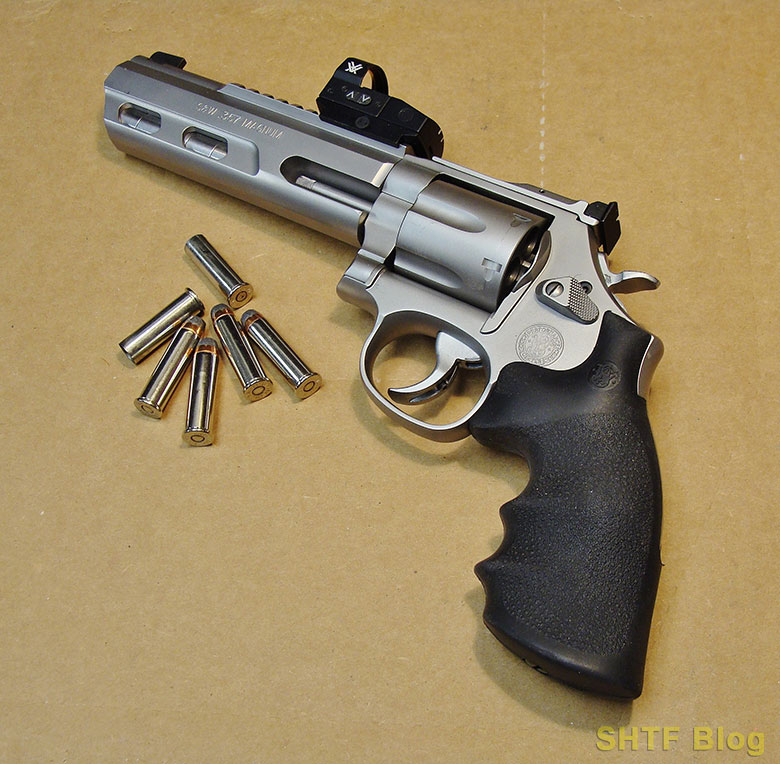
Regarding reticle uniformity, a bit of flare can be an issue with MRDS sights due to their intrinsic design. For starters the emitter’s “dot” is reflected onto the rear-facing lens surface. And lacking a focus feature, its clarity can be dependent the acuity of its user’s vision. The simple generic MRDS solution for my old eyes is a simple set of OTC reading glasses (donned for the above low-light test).
Is the Venom Worth It?
Produced in the Philippines, for many of us, its $350 retail price (closer to $250 street price) strikes a reasonable balance of features vs cost. Those on the cusp of serious social business will probably lean towards the Razor, itself made to compete with other benchmark MRDS products like those from Trijicon.
If the dot performs as advertised, once zeroed, the shooting process is simple: Put dot on target, squeeze trigger.

